Chinese anti-ship missiles. Part 1
Until the second half of the 60 of the last century, most of the western naval specialists were dismissive of guided anti-ship missiles (PKR), not considering them to be an effective means of fighting at sea. At that time, the Soviet Union was able to outrun the United States in the field of guided missile weapons, armed PKR coastal complexes, submarines, destroyers, boats and bombers. And although the first Soviet missiles were far from perfect in a number of parameters, their successful use during the Arab-Israeli armed conflict 1967 of the year later gave rise to a real "missile naval boom."
The most popular at the time, the domestic RCC P-15 had a sustained liquid two-component jet engine. It used self-igniting fuel TG-02 (“Tonka-250”) in contact with the oxidizer and the oxidizer AK-20К (liquid nitrate oxidizer). The engine worked in two modes: accelerating and marching. On the march of the flight, the rocket flew at speeds of 320 m / s. The firing range of the first modifications of the anti-ship missiles P-15 reached forty kilometers.
The P-15 rocket installed an autonomous guidance system, which included a radar or thermal homing head, autopilot, and a barometric or radio altimeter, which allowed the flight altitude to be kept within 100-200 meters above the surface. The high-cumulative warhead (BS) with a weight of 480 kilogram was designed to defeat warships with a displacement of more than 3000 tons.
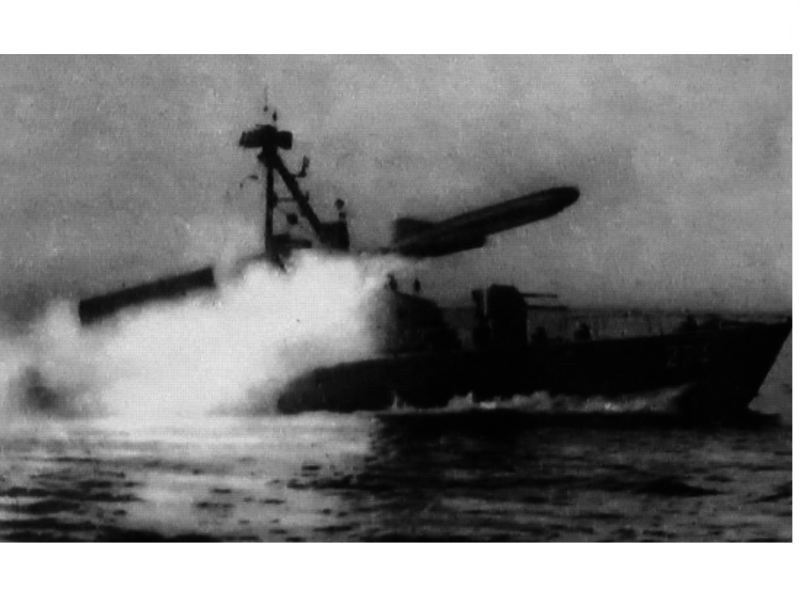
PKR P-15 together with the carriers for missile boats pr. 183P were widely exported. They were in service with the Navy: Algeria, Egypt, Cuba, North Korea and Indonesia. In China, in addition to boats and missiles, technical documentation was transferred to the P-15M anti-ship missiles, which made it possible in the first half of the 70-s to launch their mass production at the Aviation Plant No. 320 in Nanchang. The process of production of anti-ship missiles in China was strongly hampered by the “cultural revolution”. The repression against the intelligentsia and the general decline in the culture of production at that time severely limited the possibilities of Chinese science and industry in the creation of modern weapons.
In the PRC, the P-15 missiles were designated as SY-1, and apart from the missile boats, they armed frigates of the 053 avenue (such as "Jianghu"), created on the basis of the Soviet TFR of the 50 avenue and coastal missile units.
At first, the operation of the SY-1 went with great difficulty, the Chinese clearly lacked experience, knowledge and production culture, and the quality of the first RCC was very low. Often there were cases of leakage of fuel and oxidant, which in contact spontaneously ignited, which in some cases led to explosions and fires.
At the end of 70-x in China, an improved version was created - SY-1A CRP. The main differences from the early model was the use of a new impulse noise-resistant seeker and a radio altimeter. In the modification of the missile SY-XNUMHA, it was possible to get rid of leaks and to achieve the possibility of a rather long-term storage of RCC in the filled form. Advances in increasing the reliability and safety of storage, transportation and use of the SY-1 rocket allowed the creation of the first Chinese air-based anti-aircraft missile YJ-1, based on the long-range H-6 bombers. This version of the RCC could already hit targets at a distance of up to 6 km, the probability of hitting the target in the absence of interference by Chinese experts was assessed - 100.

Taking into account the complexity of operation and the danger of using rockets with rocket engines operating on a caustic oxidizer and toxic fuel, the PRC has developed a CRP SY-2 with a solid-fuel engine. However, the launch range of the SY-2 missiles did not exceed 50 km, therefore, in 80, an attempt was made to create a SY-2A ASM with a turbojet (TRD). However, at that time, for the Chinese industry, mastering the production of a small-sized turbojet engine with a high degree of reliability turned out to be a difficult task. Therefore, the development and production of new versions of rockets with a simple and inexpensive LRE continued.
Further development of the Chinese anti-ship missiles was aimed at increasing the speed and range of flight, noise immunity of the GOS and the power of the warhead, which led to the creation of the HY-1 series of missiles. On the whole, Chinese specialists went along the Soviet way of improving the CRP of the П-15 family, but advanced in this direction much further. At a time when new designs of modern anti-ship missiles with supersonic flight speeds were already created in the USSR, the People's Republic of China continued to improve the old designs, equipping them with solid-propellant and turbojet engines.
The HY-1 missiles were armed with Chinese destroyers of the 051 Ave. Improved versions of the new active radar homing were designated as - HY-1J and HY-1JА. Missiles of this type carried a cumulative warhead weighing more than 500 kg. The launch of a rocket from a carrier ship or a ground-based launcher was carried out with the help of a solid-fuel accelerator, and the work of the cruise rocket engine began in the air, at a safe distance. This significantly increased the safety of the use of rockets, as there were frequent instances of explosions at the moment of its start.
The modernization of the HY-1 guidance system and the increase in geometric dimensions led to the creation of the HK-2 RCC. Thanks to larger capacity tanks, the flight range increased to 100 km. But at the same time, an increase in tank capacity increased the size of the missiles, making it impossible for them to be placed on ship launchers. For this reason, the missiles of the HY-2 family were used only on coastal missile systems.
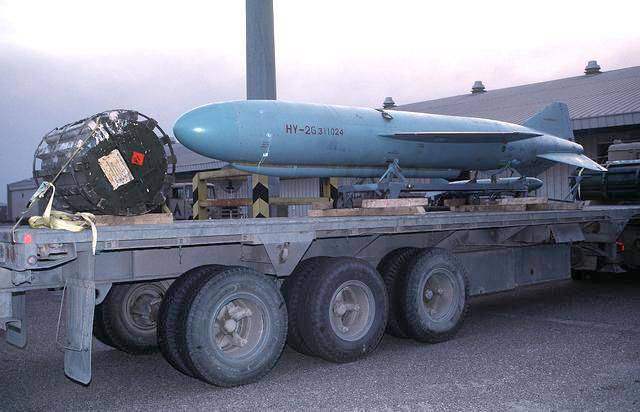
The HY-2A missile was equipped with an infrared HOS, and the HY-2B and HY-2G - with a single-pulse radar HH, HY-2С - with a television guidance system. The probability of hitting a target in the event of its capture by a radar homing vessel was assessed - 0,9. The use of an improved radio altimeter and a programmable controller on the HY-2G modification allowed the rocket to use a variable flight profile.
The creation in the People's Republic of China of a small-sized turbojet engine WS-11 made it possible to equip them with new anti-ship missiles HY-4. Chinese WS-11 is a clone of the American turbojet Teledyne-Ryan CAE J69-T-41A, which was installed during the Vietnam War on reconnaissance UAVs AQM-34. The HY-4 rocket with a launch range of up to 150 km, adopted in 1983, was a combination of guidance and control systems from HY-2G anti-ship missiles with a WS-11 turbojet engine. This engine was also used on some Chinese UAVs. Externally, the HM-4 RCC is different from the HY-2G by the presence of a lower air intake. Modification of the rocket HY-4, intended for export, received the designation C-201W.
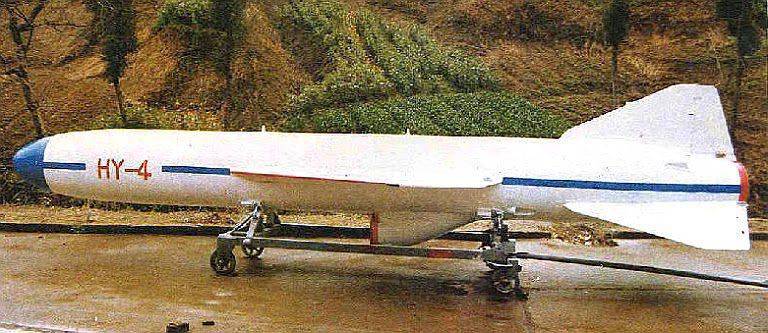
An advanced version of the rocket received the designation HY-41. According to Chinese media, the coastal missile division of the HY-41 complex can destroy targets in the sector of +/- 85 degrees, which, with a launch range of 250-300 km, depending on the flight profile, can cover the sea area of 14000 square kilometers.
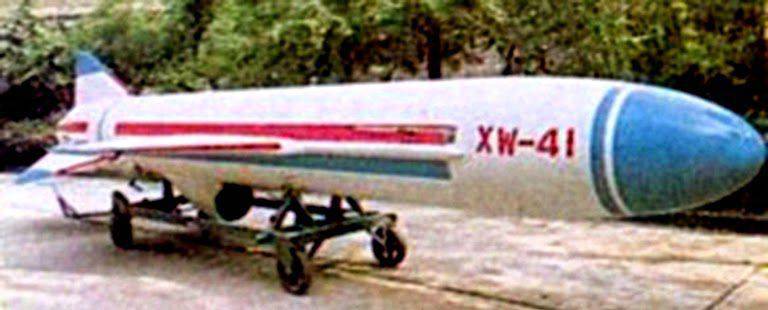
In the mid-80s in the PRC was tested and adopted aviation RCC YJ-61 (C-611), created on the basis of HY-2. , The air-based missile variant has less mass and there are no launch boosters on it. Compared to the early models of Chinese liquid-propellant rocket launchers, the carriers of which were long-range N-6 bombers, the YJ-61 rocket became easier to use and safer to handle. The launch range and the probability of hitting the target have increased.
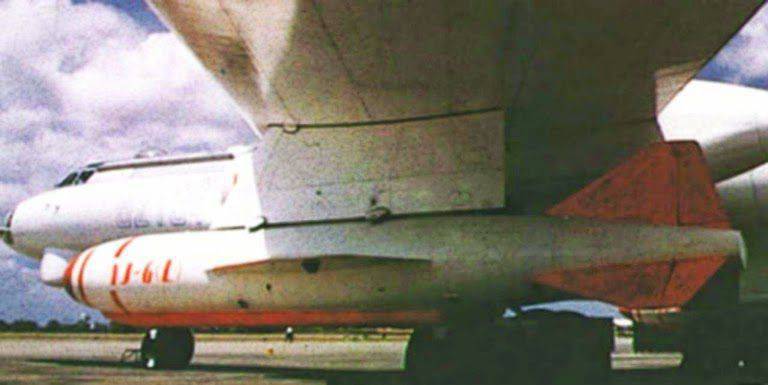
Another option for the development of RCC HY-4 was the aviation YJ-63 (C-603), adopted in 2002 year. This is the first Chinese air-to-surface missile equipped with a turbojet engine. YJ-63 is capable of striking with precision both ground and surface targets. Externally, it has retained many of the features of the previous models of anti-ship missiles, but it also has a different tail design.
RCC YJ-63 is controlled by an inertial system at the initial part of the flight, correction is performed on the middle section using satellite navigation system signals, and a television guidance system is activated at the final section. In the 2005, a variant of a rocket with a radio transparent fairing of the head section was demonstrated, under which, apparently, is a radar homing vessel. The missile launch range of the YJ-63 RCC is within 180 km, but with a subsonic flight speed this very massive rocket will be vulnerable to ship-based air defense weapons.
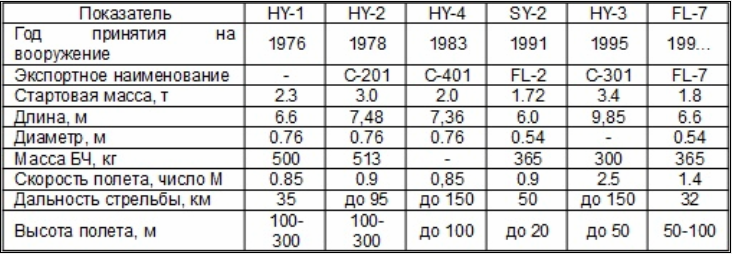
The first generation of Chinese anti-ship missiles, based on Soviet counterparts, has passed an independent development path. Despite the archaic appearance, the Chinese anti-ship missiles, created on the basis of the Soviet P-15 missile, still continue to be in service with the coastal units of the PLA Navy, and their carriers are long-range bombers. But on the warships of the Chinese fleet old rockets with liquid propellant rocket engines have almost all been replaced by modern anti-ship missiles of Chinese and Russian production with turbojet and solid fuel engines.
In addition, the anti-ship missiles, based on the SY-2, HY-1 and HY-2 missiles, to support the process of combat preparation of the air defense missile systems and testing of anti-aircraft systems in a large series were built and converted from military missiles that had served their time to radio-controlled targets.
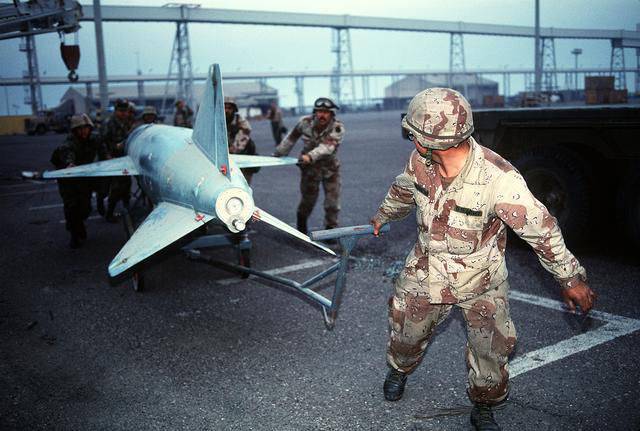
Chinese missiles that have common roots with the Soviet P-15 were shipped to Burma, Cuba, the DPRK, Iran, Iraq, the United Arab Emirates Pakistan, Sudan. DPRK and Iran have established their own production of PKR of this type. Chinese anti-ship missiles of coastal complexes, known in the west as Silkorm (Eng. Silk Warm - Silkworm), were actively used during the Iran-Iraq war and during the Gulf War in 1991. So the incident that took place in February 1991 of the year received wide publicity. Then on the American battleship USS Missouri (BB-63), the leader of the shelling of the coast, two Iraqi anti-ship missiles HY-1 were launched. On one rocket, the guidance system failed, and it left the course, the second was hit by the Sea Dart anti-aircraft missile from the British destroyer HMS Gloucester (D96).
By the middle of 80's, it became clear to the Chinese specialists that the technical solutions put into the X-NUMX-s for the P-50 rocket were already outdated and its modernization potential was almost exhausted. In this regard, an attempt was made to create its own coastal-based supersonic RCC - HY-15 (C-3).
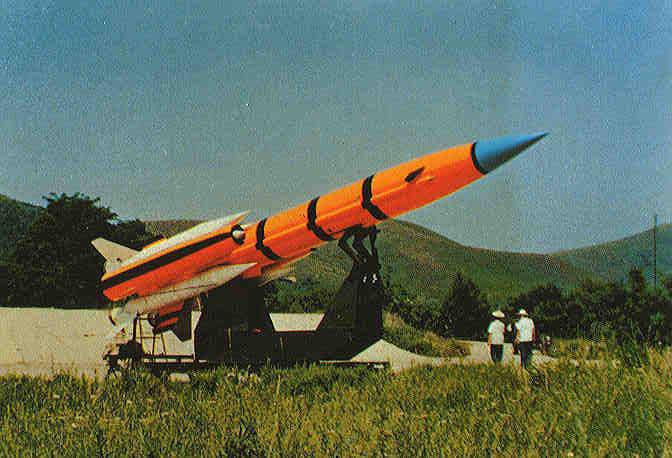
The attempt was not very successful: the rocket with a mass of about 3,5 tons had a length of almost 10 meters, which greatly hampered its transportation and masking of the coastal missile system on the ground.
The HY-3 used the warhead and hf from RCC HY-2G. The rocket launch took place with the help of four solid-fuel boosters. Two propulsion jet engines powered by kerosene were launched after reaching the 1,8M speed and accelerated the rocket to a speed greater than 2,5M. The launch range was within 150-180 km, which was clearly not enough for a rocket of this dimension.
Due to the excessive mass and dimensions of the large distribution of anti-ship missiles HY-3 did not receive, and the production of rockets was limited to an experimental batch.
At the beginning of the 90-x, the CR-FL-7 received tests. This relatively small rocket with the LRE was created with the expectation of achieving supersonic speed. It was intended to be used with Z-8 helicopters and with JH-7 fighter-bombers.
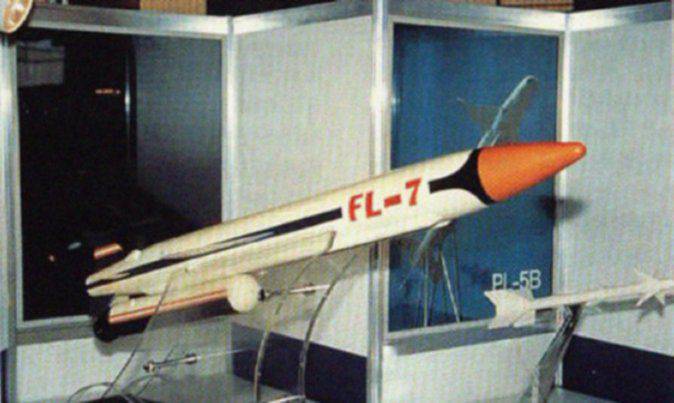
But short by modern standards, the range of launch, not exceeding 35 km, and the use of a dangerous two-component rocket engine in operation - caused the loss of interest of the PLA Navy to this rocket.
To be continued ...
Based on:
http://ndupress.ndu.edu/JFQ.aspx
http://flot.com/publications/books/shelf/reddragon/29/?print=Y
http://fas.org/man/dod-101/sys/missile/row/c-201.htm
http://www.360doc.com/content/11/0706/10/3106568_131773395.shtml
http://www.china-defense-mashup.com/2014-zhuhai-airshow
http://chinese-military-aviation.blogspot.ru/p/missiles-iii.html
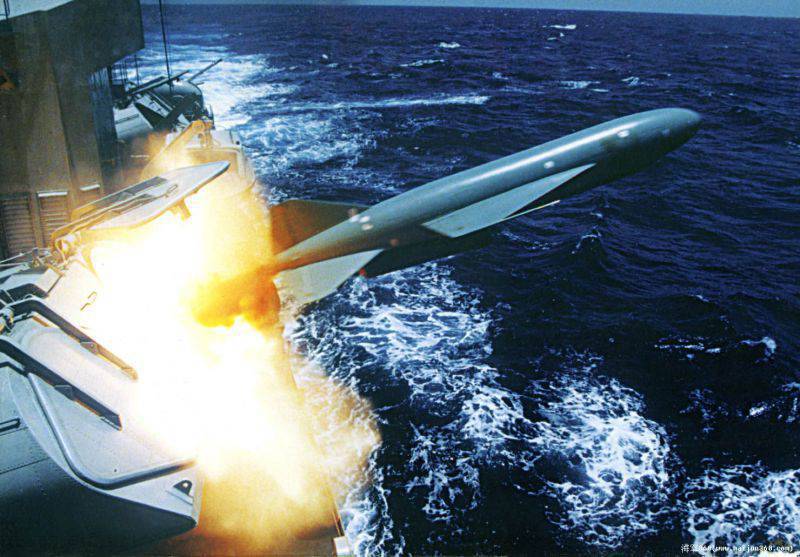
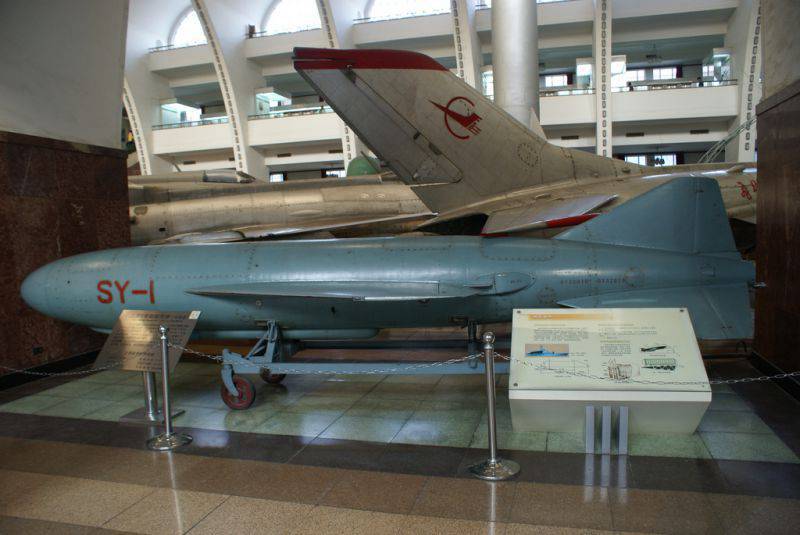
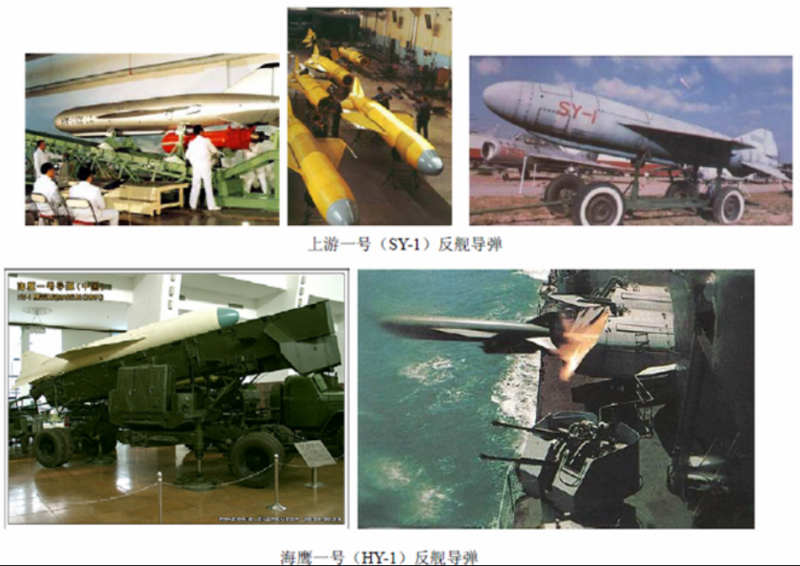

Information